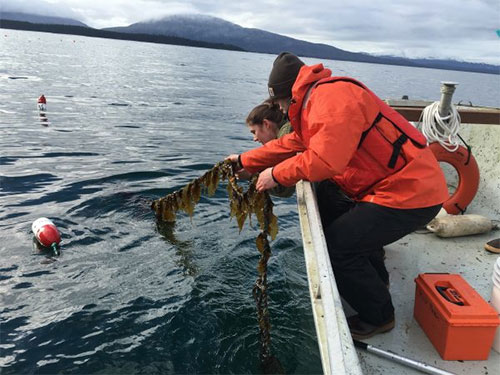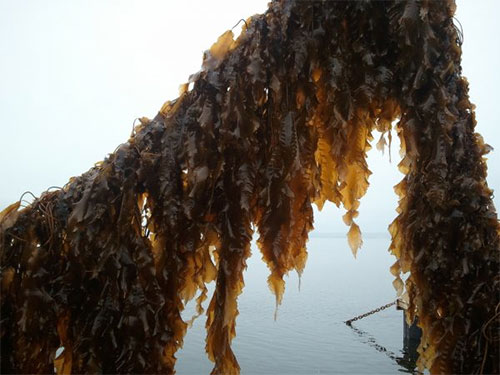
Professor studies seaweed aquacultureBy CAROL KAYNOR
November 20, 2016
The grant, administered by Alaska Sea Grant, will fund a two-year study by Michael Stekoll, a University of Alaska Southeast professor with a joint appointment at the University of Alaska Fairbanks College of Fisheries and Ocean Sciences. This research project will address questions about cultivating seaweed at higher latitudes — such as when seaweed plants become fertile, whether the timing of transferring plants to the ocean can be controlled and the optimal conditions for doing so, the best time to harvest, “cold banking” of seed and feasibility of selecting for specific traits — with the goal of helping growers become successful in this emerging industry.
Technician Tamsen Peeples and University of Alaska Southeast undergraduate Eric Fagerstrom check on a longline outplanting of Saccharina kelp at an experimental site near Coghlan Island [Coghlan Island is an island located in Stephens Passage, 1.2 miles south of Fairhaven and 11 miles northwest of the city of Juneau]
Stekoll has experimented with growing seaweed in Alaska for the last 25 years. While several Alaska seaweed species have commercial potential, his current project will focus primarily on sugar kelp. Sugar kelp may have the best chance of becoming commercially viable because it is fast-growing, grows best in the winter and has a pleasing taste, according to a commercial distributor. Stekoll’s research is expected to contribute to cultivation conditions and methods that will allow producers to grow and harvest commercial quantities of this crop and eventually other species. The state of Alaska prohibits import of any seaweeds, so seaweed farmed or grown for research in Alaska’s oceans must come from local stock. The Alaska Department of Fish and Game places extensive conditions on the mariculture of seaweeds to protect existing natural populations.
These kelp were planted experimentally on a longline on a mussel raft to see how they would grow. Blue Evolution, a U.S. seaweed-farming company, is providing some project funding and will assist with quality analysis of kelp grown as part of the project. The partnership will allow for direct transfer of Stekoll’s research into the commercial sector. Blue Evolution is also working directly with shellfish farmers in Alaska in hopes of kick-starting this new industry. Throughout the United States, the National Sea Grant College Program is providing $3.4 million in federal funding to support aquaculture research and outreach. Funding will support research on biotoxins, shellfish and seaweed culture, environmental stressors on oysters, and other topics relevant to the industry. Alaska Sea Grant, which is headquartered at the University of Alaska Fairbanks, has supported aquaculture projects in the state for decades, including shellfish culture and crab stock rehabilitation. New projects on seaweed aquaculture enhance the program’s efforts to support economies in Alaska coastal communities with applied research and outreach.
This article is provided as a public service by the University of Alaska Fairbanks. Representations of fact and opinions in comments posted are solely those of the individual posters and do not represent the opinions of Sitnews.
|
||

